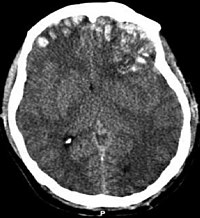
Photo from wikipedia
Mild traumatic brain injury (mTBI) is a major cause of morbidity and mortality with a poorly understood pathophysiology. Animal models have been increasingly utilized to better understand mTBI and recent… Click to show full abstract
Mild traumatic brain injury (mTBI) is a major cause of morbidity and mortality with a poorly understood pathophysiology. Animal models have been increasingly utilized to better understand mTBI and recent research has identified visual deficits in these models that corresponds to human literature. While visual impairment is being further characterized within TBI, the implications of impaired vision on behavioral tasks commonly utilized in animal models has not been well described thus far. Visual deficits may well confound behavioral tests that are believed to be isolated to cognitive functioning such as learning and memory. We utilized a mouse model of repetitive mTBI (rmTBI) to further characterize visual deficits using an optomotor task, electroretinogram, and visually evoked potential, and located likely areas of damage to the visual pathway. Mice were tested on multiple behavioral metrics, including a touchscreen conditional learning task to better identify the contribution of visual dysfunction to behavioral alterations. We found that rmTBI caused visual dysfunction resulting from damage distal to the retina that likely involves pathology within the optic nerve. Moreover, loss of vision led to poorer performance of rmTBI animals on classic behavioral tests such as the Morris Water Maze that would otherwise be attributed solely to learning and memory deficits. The touchscreen conditional learning task was able to differentiate rmTBI induced learning and memory dysfunction from visual impairment and is a valuable tool for elucidating subtle changes resulting from TBI.
Journal Title: Journal of neurotrauma
Year Published: 2021
Link to full text (if available)
Share on Social Media: Sign Up to like & get
recommendations!